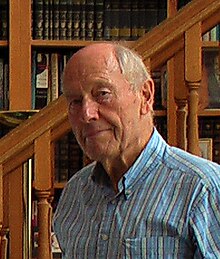David Wayne Allan | |
|---|---|
 Allan in August 2014 | |
| Born | September 25, 1936 Mapleton, Utah, United States |
| Known for | Allan variance |
| Awards |
|
| Scientific career | |
| Fields | physics |
| Institutions | National Institute of Standards and Technology |
| Website | allanstime |
David Wayne Allan (born September 25, 1936) is an American atomic clock physicist and author of the Allan variance, also known as the two-sample variance, a measure of frequency stability in clocks, oscillators and other applications.[2] He worked for the National Bureau of Standards in Colorado.[4]
Allan was born in Mapleton, Utah, on September 25, 1936. He studied physics at the Brigham Young University (B.S. 1960) and the University of Colorado (M.S. 1965).[5] From 1960 to 1992, he was a physicist in the Time and Frequency Division of the National Institute of Standards and Technology (then the National Bureau of Standards) in Boulder, and from 1979 was 1988 chief of the Time and Frequency Coordination Group.[5] He retired in 1992 and lives in Fountain Green, Utah.[5] After retirement, he consulted for Hewlett Packard from 1993 to 1997. While there, he contributed to "The Science of Timekeeping,[6] which documents his contributions to the nation as a timekeeper- generating time from an ensemble of atomic clocks and from the nation's primary frequency standard at NIST/NBS.
Allan was a consultant for the United Nations Development Programme in New Delhi in 1981 and a guest scientist in the People's Republic of China in 1982.[5]
He is a member of the Church of Jesus Christ of Latter-day Saints.[4] He has been married since 1959.[5]
- ^ Cite error: The named reference
ieeewas invoked but never defined (see the help page). - ^ a b Cite error: The named reference
itsfwas invoked but never defined (see the help page). - ^ Cite error: The named reference
ieee2was invoked but never defined (see the help page). - ^ a b Cite error: The named reference
ldswas invoked but never defined (see the help page). - ^ a b c d e Cite error: The named reference
galewas invoked but never defined (see the help page). - ^ Cite error: The named reference
scieneOfTimeKeepingwas invoked but never defined (see the help page).